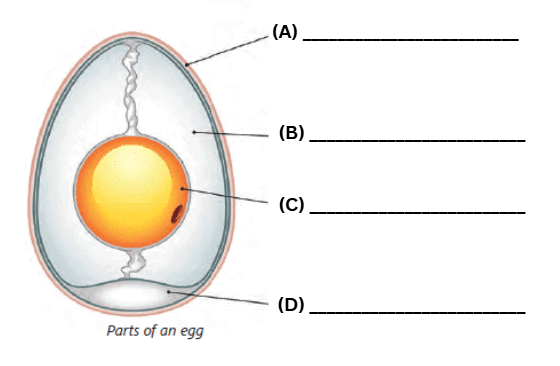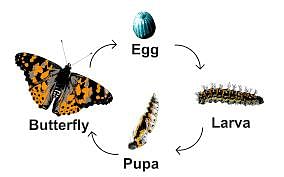Reproduction in Animals - 2 Class 4 Worksheet Science
Q1: Label the parts of an egg.

Ans: 
Q2: Fill in the blanks.
(i) The eggs of fish are hatched into _________.
Ans: fry
Fish lay eggs, and when these eggs hatch, the young fish that emerge are called fry. Fry are usually very small and may not yet resemble adult fish in terms of shape and features.
(ii) _________ the yellow round part of an egg.
Ans: yolk An egg consists of two main parts: the egg white (albumen) and the yolk. The yolk is the yellow, circular portion at the center of the egg. It contains essential nutrients and is a source of energy for the developing embryo in bird eggs or for culinary purposes in cooking.
An egg consists of two main parts: the egg white (albumen) and the yolk. The yolk is the yellow, circular portion at the center of the egg. It contains essential nutrients and is a source of energy for the developing embryo in bird eggs or for culinary purposes in cooking.
(iii) The _________ lays the biggest egg in the world.
Ans: Ostrich The ostrich, which is the largest living bird on Earth, indeed lays the largest eggs among all bird species. Ostrich eggs are quite large and can be up to 6 inches (15 centimeters) in diameter.
The ostrich, which is the largest living bird on Earth, indeed lays the largest eggs among all bird species. Ostrich eggs are quite large and can be up to 6 inches (15 centimeters) in diameter.
(iv) _________ feed their babies with their own milk.
Ans: Mammal
This is a fundamental characteristic of mammals. Female mammals have mammary glands that produce milk to nourish their offspring. They nurse their babies by providing them with milk until the young mammals are capable of consuming solid food.
(v) The larva that hatches out of a butterfly egg looks like a worm. It is called a _________.
Ans: caterpillar The life cycle of a butterfly typically involves four stages: egg, larva (caterpillar), pupa (chrysalis), and adult (butterfly). The caterpillar is the second stage in this cycle and is known for its worm-like appearance. It's the stage where the butterfly undergoes significant growth and development before forming a chrysalis and eventually emerging as an adult butterfly.
The life cycle of a butterfly typically involves four stages: egg, larva (caterpillar), pupa (chrysalis), and adult (butterfly). The caterpillar is the second stage in this cycle and is known for its worm-like appearance. It's the stage where the butterfly undergoes significant growth and development before forming a chrysalis and eventually emerging as an adult butterfly.
Q3: True or False.
(i) All the living beings do not reproduce their own kind.
Ans: False
This statement is false. Most living beings do reproduce their own kind through various methods, such as sexual reproduction (involving male and female parents) or asexual reproduction (where a single individual can produce offspring without the need for a partner). Reproduction is a fundamental biological process that ensures the continuation of species.
(ii) All animals feed their babies with their own milk.
Ans: False
This statement is false. While it is true that mammals feed their babies with their own milk, not all animals are mammals, and therefore, this behavior is not universal across the animal kingdom. Birds, reptiles, amphibians, fish, and other non-mammalian species have different methods of nourishing their offspring.
(iii) The young ones of a cat is puppy.
Ans: False
This statement is false. The young ones of a cat are called kittens, not puppies. "Puppies" is a term commonly used to refer to the young of dogs.
(iv) Mammals are warm-blooded.
Ans: True
his statement is true. Mammals are indeed warm-blooded. This means that they can regulate their internal body temperature independently of the external environment. They maintain a relatively constant body temperature, which allows them to be active in various environments and conditions.
(v) A frog goes through four stages in its life cycle.
Ans: True
This statement is true. Frogs (and many other amphibians) undergo a metamorphic life cycle consisting of four main stages: egg, tadpole, metamorph, and adult frog. The process involves significant physical changes as the frog develops from an aquatic, fish-like tadpole to a terrestrial, air-breathing adult frog capable of living on land.
Q4: Multiple Choice Questions (MCQs).
(i) Which of the following is a method of asexual reproduction in animals?
(a) Fertilization
(b) Budding
(c) Mating
(d) Courtship
Ans: (b)
Budding is a method of asexual reproduction in animals where a new individual develops as an outgrowth or bud from the parent organism. The bud eventually detaches and becomes a new independent organism. Fertilization, mating, and courtship are all related to sexual reproduction, where two parents contribute genetic material to form offspring.
(ii) The male reproductive cell in animals is called:
(a) Ovum
(b) Zygote
(c) Sperm
(d) Embryo
Ans: (c)
The male reproductive cell in animals is called sperm. It is a small, motile cell produced in the testes, and it is involved in the process of fertilization, where it fuses with the female reproductive cell (ovum) to form a zygote.
(iii) The process of giving birth to offspring in animals is known as:
(a) Hatching
(b) Fertilization
(c) Reproduction
(d) Parturition
Ans: (d)
Parturition is the process of giving birth to offspring in animals. It involves the expulsion of the developing embryo or fetus from the mother's womb.
(iv) Which of the following is an example of an oviparous animal?
(a) Cow
(b) Frog
(c) Cat
(d) Dolphin
Ans: (b)
An oviparous animal is one that lays eggs, and the young ones develop outside the mother's body. Frogs are oviparous animals, and they lay eggs in water. Cow, cat, and dolphin are viviparous animals that give birth to live young.
(v) How do fish reproduce?
(a) By laying eggs on land
(b) By laying eggs in water
(c) By giving birth to live young
(d) By producing seeds
Ans: (b)
Fish reproduce by laying eggs in water. The female fish releases eggs, and the male fish fertilizes them externally with sperm.
(vi) The process by which a tadpole changes into an adult frog is called:
(a) Metamorphosis
(b) Pollination
(c) Germination
(d) Photosynthesis
Ans: (a)
The process by which a tadpole changes into an adult frog is called metamorphosis. During metamorphosis, the tadpole undergoes significant changes in its body structure and functions to transform into a frog.
(vii) Which animal exhibits external fertilization?
(a) Human
(b) Dog
(c) Snake
(d) Frog
Ans: (d)
Frogs exhibit external fertilization, where the female releases eggs in water, and the male releases sperm to fertilize the eggs externally.
(viii) The pouch-like structure in which a kangaroo carries its young one is called:
(a) Nest
(b) Cocoon
(c) Pouch
(d) Burrow
Ans: (c)
The pouch-like structure in which a kangaroo carries its young one is called a pouch. Female kangaroos have a specialized pouch on their belly where they keep their tiny, underdeveloped young ones called joeys.
(ix) Which of the following is NOT a method of asexual reproduction?
(a) Budding
(b) Binary fission
(c) Fragmentation
(d) Sexual reproduction
Ans: (d)
Sexual reproduction involves the fusion of male and female reproductive cells and the formation of offspring with genetic variation. It is not a method of asexual reproduction. Budding, binary fission, and fragmentation are examples of asexual reproduction.
(x) In which animals does regeneration occur, allowing them to re-grow lost body parts?
(a) Birds
(b) Insects
(c) Starfish
(d) Mammals
Ans: (c)
Regeneration, the ability to re-grow lost or damaged body parts, is commonly observed in starfish. If a starfish loses an arm, it can regenerate a new one. Birds, insects, and mammals typically do not possess the same level of regenerative capabilities as starfish.
Q5: Match the following

Ans: 
Q4: Answer the following questions.
(i) What is reproduction?
Ans: Reproduction is the process by which 1ng beings produce their own kind.
(ii) Who are mammals?
Ans: Mammals give birth to their young ones directly. They feed them with their own milk and take care of them.
(iii) Name the smallest mammals.
Ans: Pygmy is the smallest mammals.
(iv) Name two animals that lay their eggs in water.
Ans: Frog and fish lay their eggs in water.
(v) Name any five egg-laying animals.
Ans: Birds, fish, snakes, turtles and frogs are the egg-laying animals.
(vi) Name two animals that do not take care for their young ones.
Ans: Snakes and lizards do not take care for their young ones.
(vii) What are the life-stages of a butterfly?
Ans: The life-stages of a butterfly through egg, caterpillar, pupa and pupa transforms into butterfly.
|
50 videos|93 docs|28 tests
|
FAQs on Reproduction in Animals - 2 Class 4 Worksheet Science
| 1. What is reproduction in animals? |  |
| 2. What are the two main types of reproduction in animals? |  |
| 3. How do animals reproduce sexually? |  |
| 4. Can you give examples of asexual reproduction in animals? |  |
| 5. Why is reproduction important for animals? |  |


















